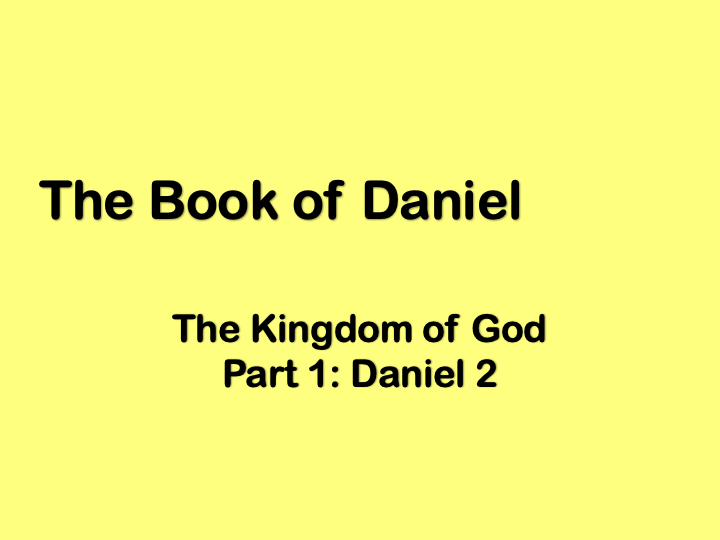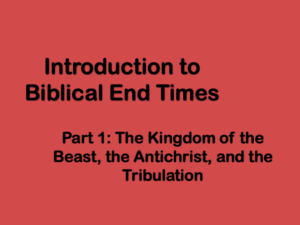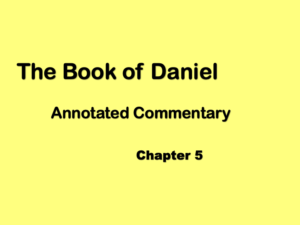The Kingdom of God
Two major end times topics are introduced in the 2nd chapter of the Book of Daniel. The first is the One World Order, or the Kingdom of the Beast, which we discussed in a previous post. The second is the Kingdom of God, which we discuss in this post.

Part 1: Daniel Chapter 2
The Kingdom of God is an important topic in Biblical end times, or eschatology. While many of the Old Testament prophets and writers discuss the Kingdom of God, many details are introduced in Daniel.
A Final Kingdom will replace the Kingdoms of Men
In Daniel Chapter 2, Nebuchadnezzar, the king of Babylon, had a dream of a statue made of different materials. Daniel told Nebuchadnezzar each material of the statue represented a different kingdom, and the first kingdom, the head of gold, was Babylon, ruled by Nebuchadnezzar. Four other kingdoms would follow Babylon, but eventually the statue, and the kingdoms, would be destroyed by a stone.
“You saw until a stone was cut out without hands, which struck the image on its feet that were of iron and clay, and broke them in pieces. Then was the iron, the clay, the brass, the silver, and the gold, broken in pieces together, and became like the chaff of the summer threshing floors; and the wind carried them away, so that no place was found for them: and the stone that struck the image became a great mountain, and filled the whole earth.”
Daniel 2: 34-35
The stone that destroys the statue is “cut out without hands.” Since men must use their hands to create, an object made “without hands,” cannot be manmade. This language implies that the stone is supernatural in origin.
In a previous post, we discussed that the Kingdom of the Beast, a final kingdom of men, is represented by the feet made of a mixture or iron and clay. The stone strikes the statue “on its feet” This tells us God’s kingdom will occur at the time of the Kingdom of the Beast. Additionally, since the stone destroys not only the feet, but the entire statue, we learn the stone will destroy not only the Kingdom of the Beast, but also all the kingdoms that came before.
Does this mean Babylon, Persia, Greece and perhaps Rome will all exist in some form during the Kingdom of the Beast, or does it reference the Kingdom of the Beast as the summation, or pinnacle of the previous kingdoms? Daniel doesn’t give us enough information to know for sure, but there is language in Revelation that suggests the Kingdom of the Beast does include some resurrected from of the previous kingdoms.
In the dream, all the previous kingdoms “became like the chaff of the summer threshing floors” and were scattered by the winds until no remnant remained. Chaff is the inedible portion of grains. In ancient agriculture, grain was harvested and laid out to dry. After it dried, straw was removed, then grain head, consisting of the grain and the chaff, was tossed into the air. Since the grain was heavier, it would fall to the ground, while the lighter chaff would blow away in the wind. The imagery of the chaff shows God’s view of the previous kingdoms of men. They are the useless portion of the harvest to be discarded. In the dream, “no place was found” for the previous kingdoms, so no remnant will remain.
The stone does more than destroy the kingdoms of men, it becomes a new, supernatural kingdom. After destroying the statue, the stone grows into a “great mountain” and fills “the whole earth.” This means the stone will replace the previous kingdoms with a new kingdom, a kingdom that will rule the entire earth.
The Stone is God’s Kingdom
A few verses later in Chapter 2, Daniel interprets the dream for Nebuchadnezzar and gives more details.
“In the days of those kings the God of heaven will set up a kingdom which will never be destroyed, nor will its sovereignty be left to another people; but it will break in pieces and consume all these kingdoms, and it will stand forever. Because you saw that a stone was cut out of the mountain without hands, and that it broke in pieces the iron, the brass, the clay, and silver, and the gold; the great God has made known to the king what will happen hereafter. The dream is certain, and its interpretation sure.”
Daniel 2: 44-45
Daniel clarifies the stone is a kingdom that God will set up. He also states it will “never be destroyed,” and “it will stand forever,” which means God’s kingdom will be eternal, with no end. Daniel also says the sovereignty will not be “left to another people.” Sovereignty is the ultimate authority of a kingdom or a nation. In the kingdoms represented by the statue, the sovereignty was a gentile people, represented by the king. Now, the ultimate authority will not be another gentile people, which means either God himself will be the ultimate authority, or perhaps instead of being left to a gentile people, God’s people will be the ultimate authority.
Summary
In Daniel, Chapter 2, we learn that a series of kingdoms and rulers will dominate the known world, starting with Nebuchadnezzar and the Babylonians. After the final kingdom, a kingdom symbolized by a mixture of clay and iron, the kingdoms of men will be destroyed and replaced by a supernatural kingdom, one that is ruled by God.
Kingdom of God Elsewhere in the Bible
The idea of the Kingdom of God is developed further in later chapters of Daniel and even more in Revelation. While the term “Kingdom of God” is only used in two places in the Old Testament (both are in Chronicles), it is referred to often by the prophets. They speak of a time when God will rule on Earth. Often God’s future kingdom is linked to a descendant of King David. God’s future kingdom is also often linked to a future day of judgement, known as “the Day of the Lord.”
The Kingdom of God, sometimes called the Kingdom of Heaven, occurs often in the gospels and is a frequent topic of Jesus’ teachings. Jesus, who is described as a descendant of David, often told his disciples the time of the kingdom was very near.
When Does the Kingdom of God Begin?
Just as Biblical scholars disagree about the timing of the Kingdom of the Beast, they also disagree on the timing of the Kingdom of God. The two major views can be separated into the Preterist view, which holds the Kingdom of God started soon after the crucifixion, and the Futurist view, which holds the Kingdom of God is still in the future.
Preterists cite Jesus’ teaching that the Kingdom of God was imminent as evidence that we are currently living in the Kingdom. Since Jesus, as God, is inerrant, then the Kingdom must have started soon after his ministry. Preterists propose the Kingdom of God started around the time of the crucifixion and the resurrection of Jesus Christ.
Futurists cite many unfulfilled prophecies about end times as evidence the Kingdom is still future. While they acknowledge the teaching of Jesus, they believe Bible is inerrancy requires these prophecies to be fulfilled literally. Since these prophecies have not been fulfilled literally, the Kingdom must still be future. Futurists propose the Kingdom of God will start with the Millennial Kingdom, a literal 1,000-year reign that starts after the second coming of Christ.
In the next post, we’ll further explore the Preterist vs. Futurist debate.




